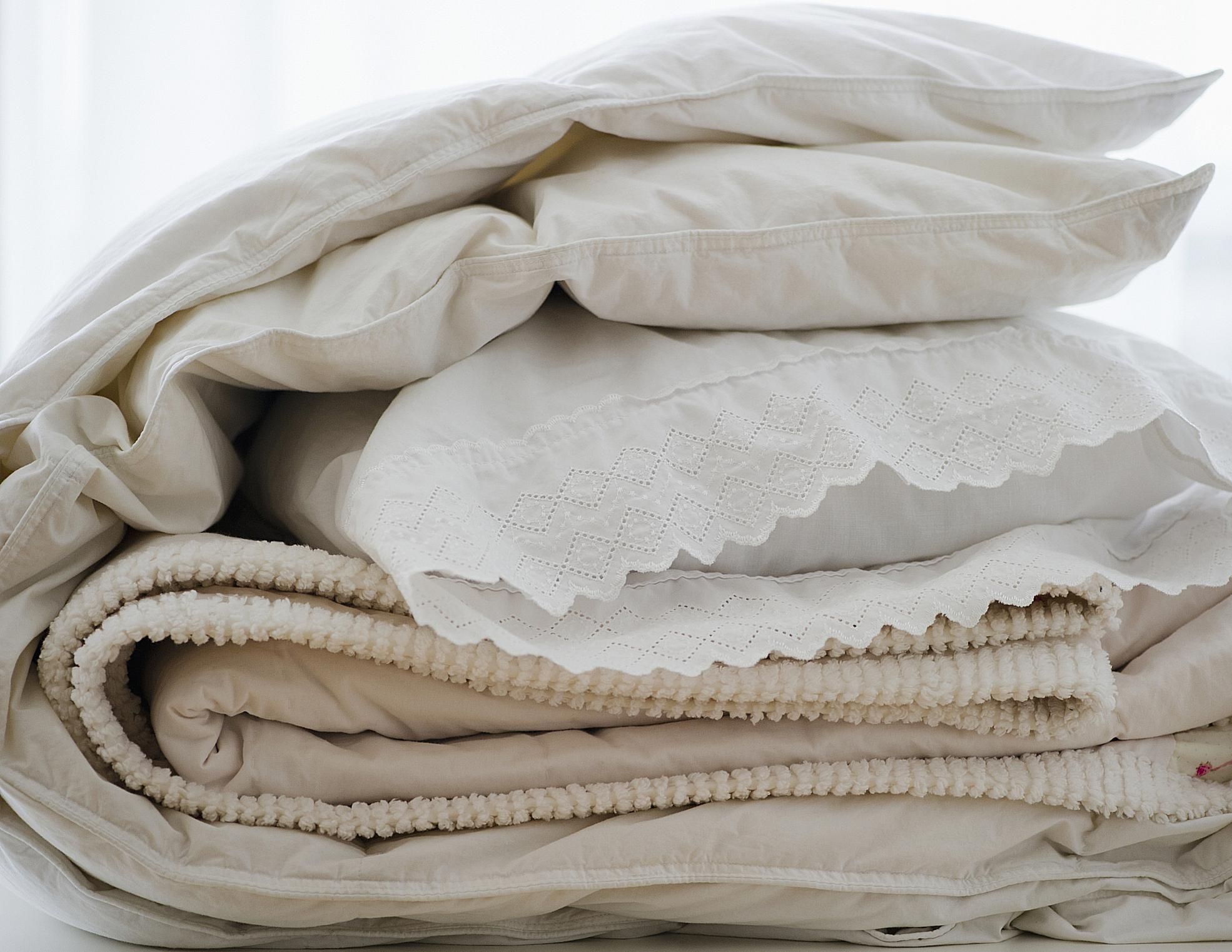

Articles
How To Store A Duvet
Modified: January 7, 2024
Looking for tips on how to store a duvet? Our informative articles will guide you on the best methods to keep your duvet fresh and protected.
(Many of the links in this article redirect to a specific reviewed product. Your purchase of these products through affiliate links helps to generate commission for Storables.com, at no extra cost. Learn more)
Introduction
Storing a duvet properly is essential to keep it clean, fresh, and in good condition. Whether you are storing it during the warm months or just need to keep it safely tucked away, following the right steps will help ensure its longevity. In this article, we will guide you through the process of storing a duvet, from cleaning it to choosing the right storage option and properly folding and wrapping it.
A duvet is a type of bedding that consists of a soft, fluffy insert filled with down, feathers, or synthetic materials. It is covered by a removable duvet cover, which can be easily washed to keep it clean. Proper storage of a duvet is essential to protect it from dust, insects, moisture, and any potential damage.
So, if you’re wondering how to store a duvet correctly, let’s dive into the step-by-step process!
Key Takeaways:
- Properly cleaning and storing your duvet is essential for maintaining its quality and freshness. Follow these steps to ensure your duvet remains clean, protected, and easily accessible for future use.
- Regular maintenance and airing of your stored duvet will help prolong its lifespan and ensure it remains fresh and in optimal condition for future use.
Read more: How To Store Duvets
Step 1: Cleaning the Duvet
Before storing your duvet, it’s crucial to clean it thoroughly. This will help remove any dirt, dust, or allergens that may have accumulated over time. Follow these steps to ensure a clean duvet:
- Check the care label: Start by checking the care label attached to your duvet. It will provide instructions on how to clean it, including whether it can be machine washed or if it needs to be dry cleaned.
- Machine washable duvets: If your duvet is machine washable, place it in a large front-loading washing machine. Use mild detergent and set the machine to a gentle cycle with cold water to prevent any damage to the fabric or filling.
- Dry clean only duvets: If your duvet is labeled as “dry clean only,” take it to a professional dry cleaner. They have the expertise and equipment to clean delicate bedding properly, ensuring it stays in good condition.
- Special care for down duvets: If you have a down duvet, make sure to dry it thoroughly. Use a low heat setting in the dryer and add a few clean tennis balls or dryer balls to fluff up the down filling.
- Remove stains: If your duvet has any stains, treat them before washing. Follow the instructions on the stain remover product, and test it on a small, inconspicuous area of the duvet first to ensure it doesn’t cause any damage.
- Air dry: Once the duvet is clean, avoid using a tumble dryer if possible. Instead, air dry it by hanging it outside on a clothesline or laying it flat on a clean surface in a well-ventilated area. Make sure it is completely dry before proceeding to the next steps.
Cleaning your duvet before storage will not only eliminate any odors or dirt but also help maintain its quality and keep it fresh for future use.
Step 2: Choosing the Right Storage Option
Once your duvet is clean and dry, it’s important to select an appropriate storage option to protect it from dirt, dust, and potential damage. Consider the following factors when choosing the right storage option:
- Size: The size of your duvet will determine the type of storage option you need. If you have limited space, look for storage bags or boxes specifically designed for bedding that can accommodate your duvet’s dimensions.
- Material: Opt for storage options that are made of breathable materials, such as cotton or fabric blends. This will allow proper air circulation and prevent moisture build-up, which can lead to mold or mildew formation.
- Protection: Look for storage solutions that provide protection against dust, insects, and moisture. Some options come with zipper closures or have built-in features to keep your duvet safe and secure.
- Visibility: Consider storage options that allow you to easily see the contents. Transparent or semi-transparent storage bags or boxes will help you quickly identify the duvet without having to open multiple containers.
- Stackability: If you have multiple duvets or bedding items to store, choose storage options that can be stacked on top of each other. This will help save space and keep everything organized.
- Location: Decide where you’ll be storing your duvet. If it’s going in a closet or under a bed, make sure the storage option is compatible with the available space. If you’re storing it in a basement or attic, consider using plastic storage containers to protect against potential moisture.
By taking these factors into account, you can select a storage option that ensures your duvet remains clean, protected, and easily accessible when you need it again.
Step 3: Folding the Duvet
Properly folding your duvet is essential to minimize creases and ensure that it fits neatly into the chosen storage option. Follow these steps to fold your duvet efficiently:
- Spread it flat: Start by spreading your duvet flat on a clean, large surface, such as a bed or table. Smooth out any wrinkles or uneven areas.
- Divide into sections: Divide the duvet into thirds lengthwise. This will make it easier to fold and reduce the overall volume.
- Fold in thirds: Take one end of the duvet and fold it towards the center, creating a third of the length. Then, fold the opposite end towards the center, overlapping the first fold. This will create a compact, folded duvet.
- Roll tightly: If you prefer a more space-saving option, you can roll the folded duvet tightly from one end to the other. Rolling can help reduce the size and make it easier to fit into storage bags or boxes.
- Smooth out wrinkles: As you fold or roll the duvet, make sure to smooth out any wrinkles or uneven areas. This will help maintain the duvet’s shape and prevent deep creases from forming.
- Secure with straps or ties: If your duvet storage option has straps or ties, use them to secure the folded duvet in place. This will prevent it from shifting or unfolding during storage.
- Avoid overstuffing: It’s important not to overstuff the storage option with too many duvets or bedding items. Overcrowding can lead to unnecessary compression and potential damage to the duvet’s filling.
By following these steps, you can fold your duvet in a way that minimizes wrinkles, saves space, and ensures it remains well-preserved during storage.
Store your duvet in a breathable cotton storage bag to prevent moisture build-up and keep it fresh. Avoid plastic bags, as they can trap moisture and cause mildew.
Step 4: Wrapping the Duvet
Wrapping your duvet provides an extra layer of protection and keeps it clean during storage. Follow these steps to properly wrap your duvet:
- Choose a protective cover: Select a duvet cover or a large, clean bedsheet to wrap your duvet. Make sure the cover is big enough to fully enclose the folded duvet without being too tight.
- Open the cover: Lay the duvet cover or bedsheet flat on the floor or bed, ensuring that it’s spread out evenly with all corners unfolded.
- Place the duvet in the center: With the folded duvet in hand, place it in the center of the cover or bedsheet. Ensure that the top of the duvet aligns with the top edge of the cover.
- Bring up the sides: Carefully bring up the sides of the cover, ensuring that they fully cover the duvet. Smooth out any wrinkles or lumps as you go.
- Secure the closure: Depending on the closure type, either zip up, button, tie, or fold over the cover to secure it tightly around the duvet. Make sure the closure is secure but not excessively tight to avoid putting pressure on the duvet.
- Label the cover: To easily identify the duvet in storage, consider labeling the cover with a tag or write the contents on a piece of masking tape and attach it to the cover.
By wrapping your duvet in a protective cover, you can safeguard it from dust, dirt, or any potential damage while ensuring it remains in pristine condition during storage.
Read more: How To Style A Duvet
Step 5: Storing the Duvet in a Safe Place
Once your duvet is cleaned, folded, and wrapped, it’s time to store it in a safe place where it will be protected from environmental factors and potential damage. Follow these steps to store your duvet properly:
- Select a cool, dry location: Choose a storage area that is cool, dry, and away from direct sunlight. Extreme temperatures and humidity can affect the quality of the duvet and lead to mold or mildew growth.
- Avoid storing on the floor: It’s best to avoid storing the duvet directly on the floor, as it can be susceptible to dust, moisture, or pests. Utilize shelves, closets, or raised storage units to keep it elevated and off the ground.
- Protect against pests: Place mothballs or a natural alternative, such as lavender sachets, cedar chips, or dried mint leaves, near the duvet to deter pests. Avoid placing them directly on the duvet to prevent any potential staining or odor transfer.
- Consider vacuum sealing: If you have limited storage space or want extra protection, consider using a vacuum sealer. These devices remove excess air from the storage bag, compressing the duvet to a smaller size and providing an airtight seal.
- Avoid plastic containers: While plastic storage containers can provide protection against moisture, they may not allow proper air circulation. If using plastic containers, make sure to include moisture-absorbing packets or desiccants to prevent any moisture buildup.
- Label and organize: Clearly label the storage container or bag with the contents to easily identify the duvet later. Additionally, organize your storage area so that you can access the duvet easily when needed.
- Inspect periodically: Regularly check on your stored duvet to ensure there are no signs of damage, moisture, or pests. If any issues are discovered, take necessary actions to resolve them immediately.
By following these guidelines, you can store your duvet in a safe and secure manner, protecting it from potential damage and ensuring it remains in excellent condition for future use.
Step 6: Regular Maintenance and Airing of the Duvet
Even when your duvet is safely stored away, it’s important to perform regular maintenance and airing to keep it fresh and in optimal condition. Follow these steps to maintain your duvet during storage:
- Air the duvet periodically: Every few months, take the opportunity to air out your stored duvet. Lay it flat on a clean surface or hang it outside in a well-ventilated area for a few hours. This will help remove any trapped odors and allow fresh air to circulate through the filling.
- Fluff the duvet: After airing, give your duvet a good shake or gentle fluff to redistribute the filling evenly. This will help restore its loft and keep it nice and fluffy.
- Check for moisture: During the airing process, inspect the duvet for any signs of moisture or dampness. If you notice any, allow the duvet to dry completely before returning it to storage to prevent mold or mildew growth.
- Replace storage options if needed: Over time, storage bags or containers can become worn or damaged. If you notice any signs of deterioration, replace them to ensure continued protection for your duvet.
- Handle with care: When retrieving or returning the duvet from storage, handle it with care to avoid snagging or tearing. Hold it from the bottom or sides, rather than grabbing or pulling from the top, to minimize stress on the fabric.
- Monitor the storage environment: Regularly check the storage area for changes in temperature and humidity. If you notice any significant fluctuations, consider moving the duvet to a more stable environment to prevent potential damage.
- Follow manufacturer’s instructions: Always refer to the care instructions provided by the duvet manufacturer for specific maintenance recommendations. Different materials may require different care methods, so it’s essential to follow their guidelines.
By performing regular maintenance and airing, you can prolong the lifespan of your duvet and ensure its freshness when it’s time to use it again.
Frequently Asked Questions about How To Store A Duvet
Was this page helpful?
At Storables.com, we guarantee accurate and reliable information. Our content, validated by Expert Board Contributors, is crafted following stringent Editorial Policies. We're committed to providing you with well-researched, expert-backed insights for all your informational needs.















0 thoughts on “How To Store A Duvet”